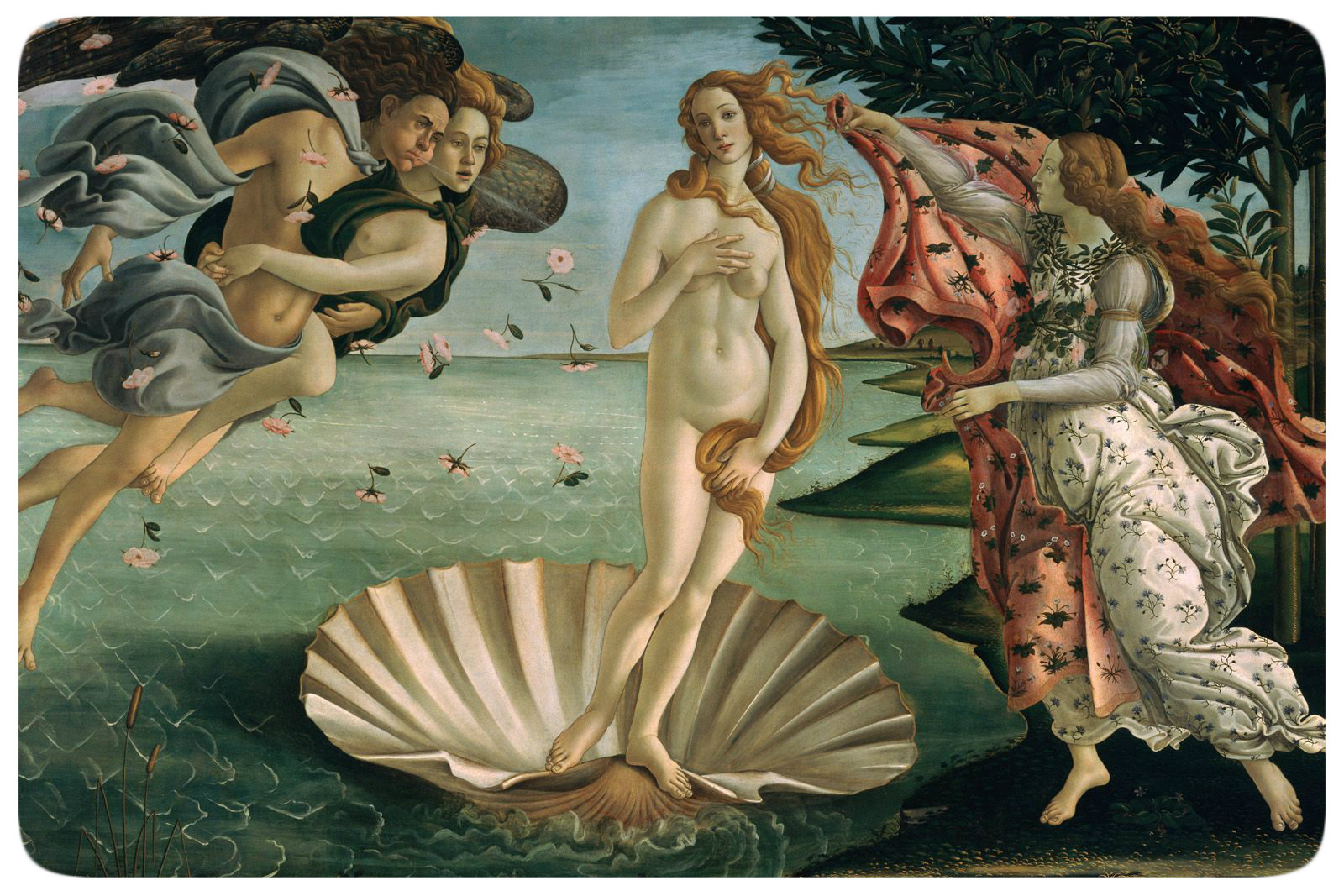
Sandro Botticelli. The Birth of Venus. (1484-1486). 1.72 m x 2.78 m.
LONDON — Physically, the biggest Botticelli of all would never fit in a museum. It is 143 kilometres wide — a crater on the planet Mercury named after the Florentine artist. But Sandro Botticelli (1445-1510) generated something even bigger, a meme that has spanned planet Earth: an ideal of liberated female beauty, represented by his Venus. Why has this image proved so powerful?
At the Victoria and Albert Museum (V&A), the Botticelli Reimagined exhibition (until 3rd July 2016) charts it, in what co-curator Mark Evans calls 'the adventure of an idea'. The show runs the adventure backwards, grabbing attention with the eye candy of today's art and artifacts right up-front, and leaving his own work to the last. There we confront two great enigmas — Botticelli's relationship with the secular and sacred, and who exactly he based his ideal beauty on. Her image lives and mutates after five centuries, but she may be someone who died aged just 22.
Essentially just two Botticelli images drive the explosion of modern works. Foremost is his Venus in The Birth of Venus, from the mid 1480s — the goddess of love as a young woman standing on a huge seashell, only her arms offering a casual modesty to her nakedness, and her hair wild and free in the wind. A fold of hair by her thumb could suggest labia. To her right, the Winds are an airborne couple, and to her left, Hora or Flora in a flowery dress throws a cloak towards her. This Venus is imprinted in our collective mind as much as da Vinci's Mona Lisa.
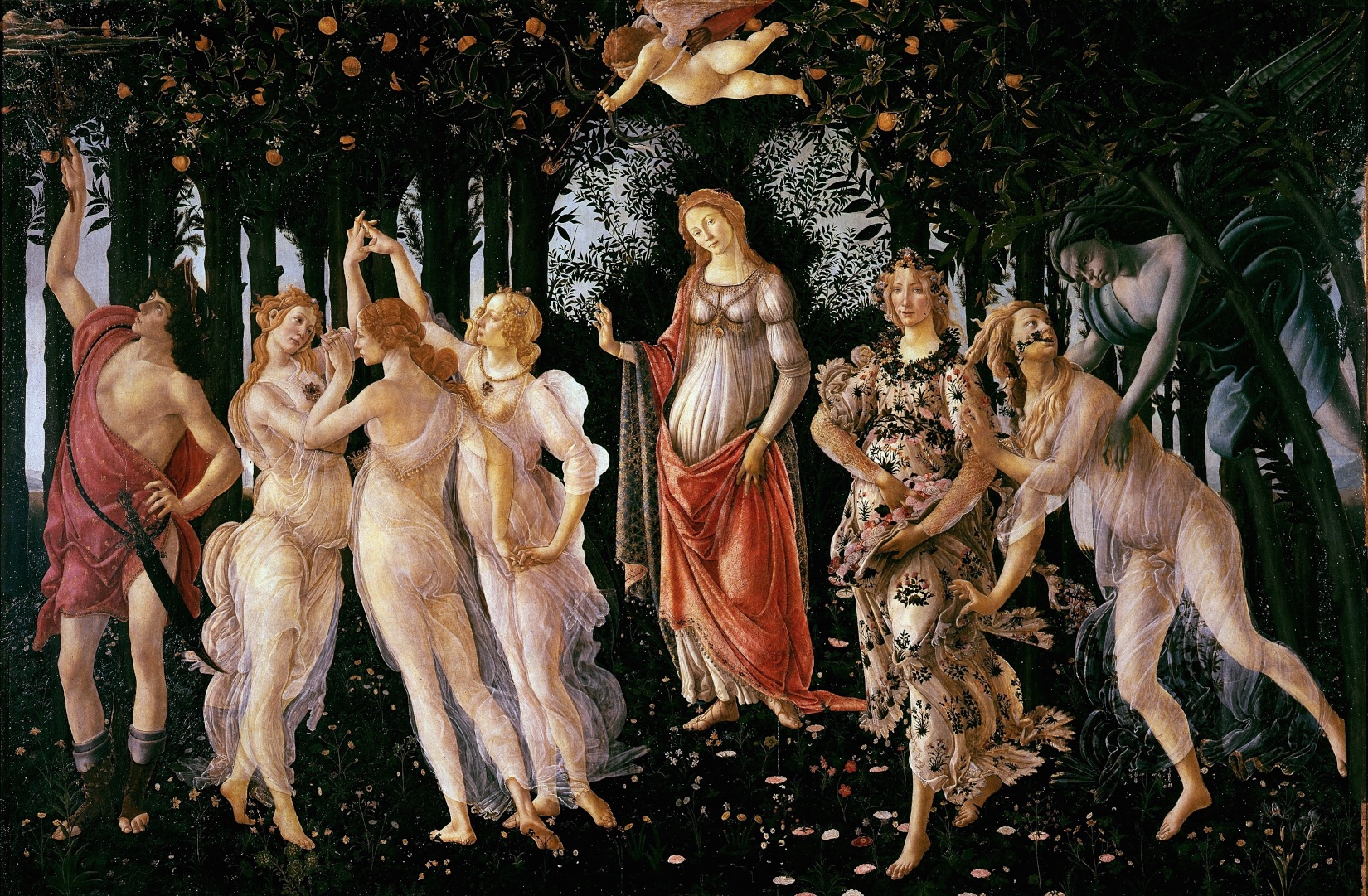
Sandro Botticelli. Primavera. 1482. 202 cm × 314 cm (80 in. × 124 in.)
Second is Primavera, painted around 1482, set in a wood and again with a centrally-placed Venus, and to her side, Flora — wearing that same flowery dress and with flowers in her hair — looks directly at us, in a way as familiar as someone glancing across a contemporary café. The Three Graces dance. All figures are at one with nature. Both these pictures remain in the Uffizi Gallery in Florence, too precious to move.
Less appropriated but in the collective conscious is Venus and Mars (in London's National Gallery), also mid 1480s, in which satyrs lark behind the couple. He is almost naked and has nodded off. She mirrors his reclining position but looks into the distance, contemplative and, perhaps, disappointed.
Like a vanitas, it reminds us how fleeting life and looks are.
Botticelli Reimagined is a show of three thirds. The first one starts with Ursula Andress stepping out of the sea in a clip from the early Bond film Dr No. The scene is an analogue of the Birth of Venus, but this woman is far from demure and innocent. Similarly, the Venus 1975 retro-hip sci-fi pulp paperback cover of Philip José Farmer's Venus on the Half-Shell — and Jeff Koons' artwork for Lady Gaga's Artpop (2013) in which she sits spread-legged on a shell — are about temptation, not innocence. Dolce & Gabana's 'Look 13 trouser suit and Venus dress', both printed with montages of details from the Birth of Venus, are gorgeous, synthesising printed image as a third element in the visual mix of the cut and the wearer, to amplify beauty. All these show how Botticelli 's Venus has traveled far beyond art circles. The OZ Botticelli III Wheel, designed for racing cars, however, has as much to do with Botticelli as the crater on Mercury.
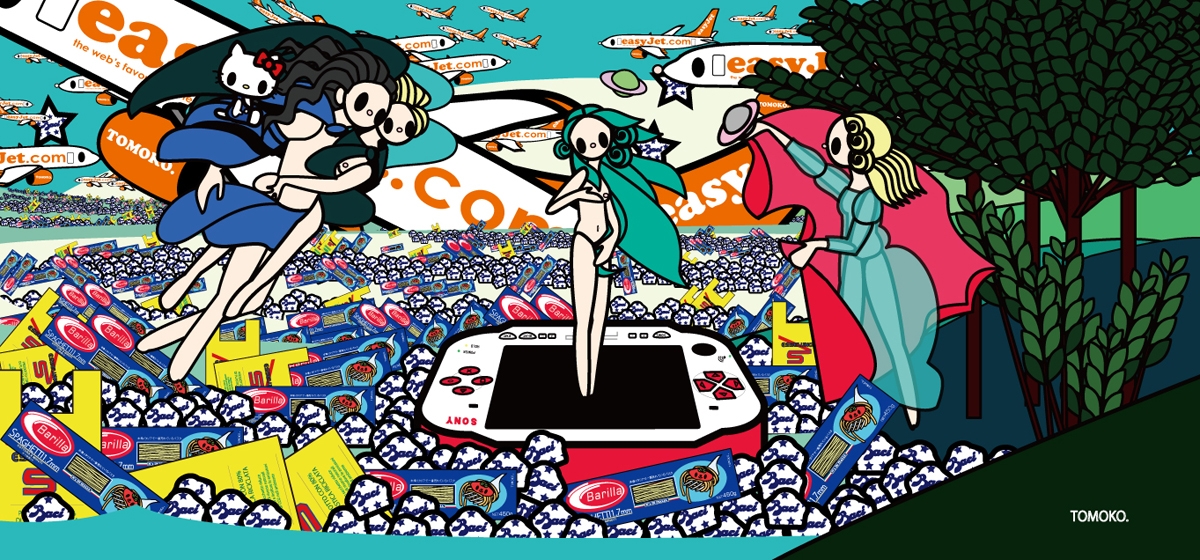
Tamoko Nagao. The Birth of Venus with Baci, Esselinga, PSP and Easyjet (2014). Digital content, 50 x 70 cm; 20 in x 28 in.
In a parade of visual images, which is 'art' in the conventional sense, the fields of photography, Pop and conceptual art rub shoulders — each with different messages. When Venus gets the Andy Warhol fluorescent colour treatment, you know her celebrity is up there with the likes of Marilyn Monroe and Elizabeth Taylor, so no wonder the V&A has branded the show with his 1984 acrylics. Alain Jacquet's double canvas Camouflage Botticelli, naissance de Venus (1964), a Pop take on Shell petrol pumps, speaks of American capitalism, while Tamoko Nagao's plastic-fantastic montage The Birth of Venus with Baci, Esselinga, PSP and Easyjet (2014) is a riotous comment on contemporary branding and globalisation. Robert Rauschenberg's photographic triptych Swim/ROCI USA (1990) has a statue of Venus at its centre, representing a European source from which culture disseminated to America.
But beauty itself is the theme for most modern artists, and they present different ideas about it. Paris-based Chinese artist Yin Xin's stunning Venus, after Botticelli (2008) is Chinese. When asked about Western and Chinese ideas of beauty, Yin said, "I like both”. His work often transposes Western art icons with Chinese faces, and includes a Chinese Mona Lisa and Pope Innocent X in the Velasquez pose (the one Bacon re-imagined). French feminist artist ORLAN, however, has a different agenda: 'I work to question the idea of beauty'. The V&A show her 1975 work Occasional Striptease with Trousseau Sheets, a photographic sequence of her de-robing from a nun's habit to finally stand naked in Venus pose. ORLAN looks at that image in a photo from Operation Opera (1991), a performance piece about plastic surgery which also features surgeons, fruit and a lobster. In her Hybridization of Botticelli’s Venus and ORLAN’s Face, in-between Hybridizations (1990), she has photoshopped her own distorted face over Venus'. "I try to deconstruct beauty", commented ORLAN.
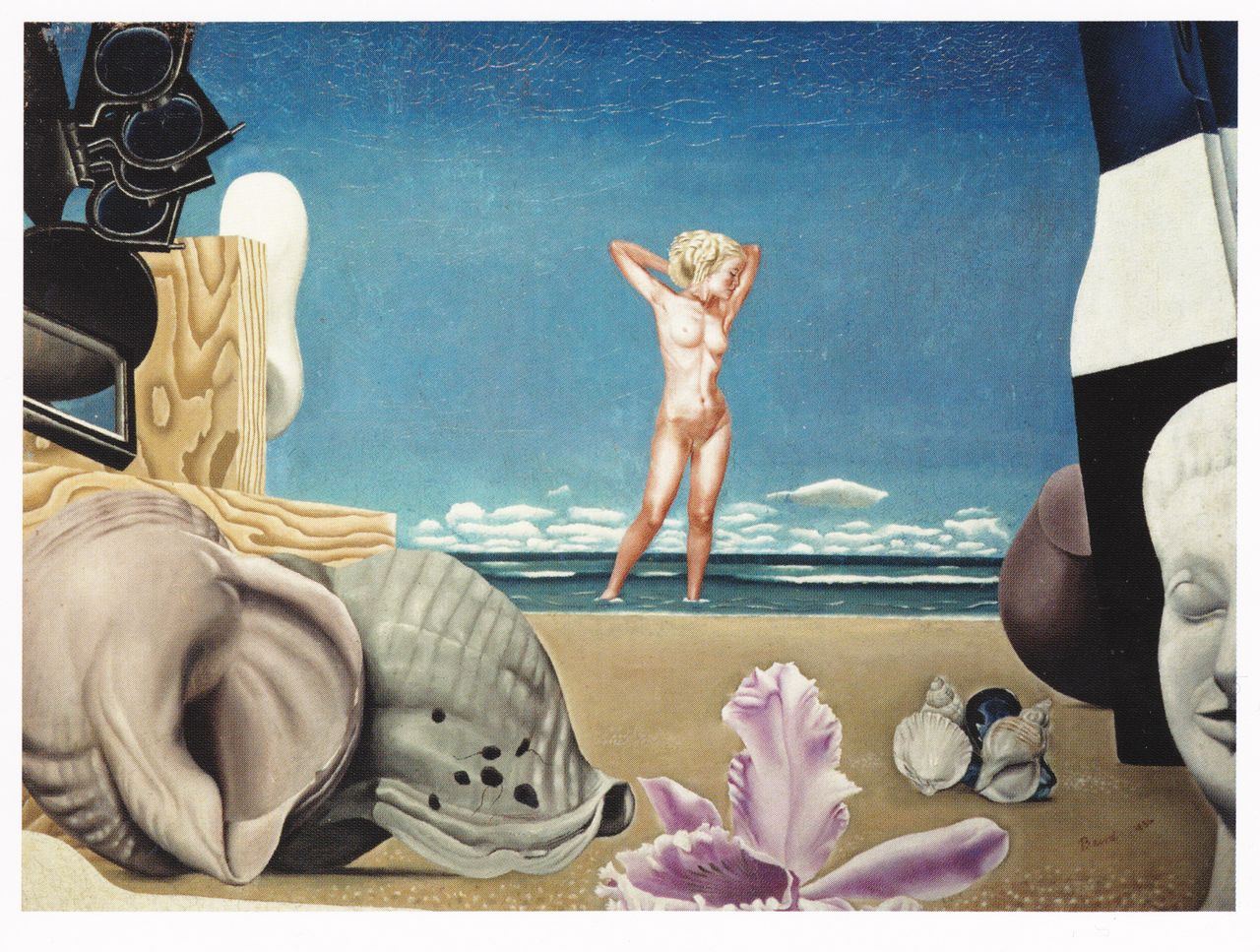
Edward Baird, The Birth of Venus (1934). 51 x 69 cm; 20 x 27 in.
Surrealists appear in the V&A show. Salvador Dali replaces Venus' head with a fish's in the print montage for Declaration of the Independence of the Imagination and the Rights of Man to His Own Madness (1939). Botticelli's Flora floats before Magritte's hallmark anonymous bowler-hatted man in Le bouquet tout fait (1957). A surprise is Edward Baird's Birth of Venus (1934), in which a Scottish blonde in the sea is framed by surrealistic objects on the beach. His celebration of beauty is sexually-charged in stark sunlight.
The show's next section, Botticelli Rediscovered, takes us back to the nineteenth century, but includes a tantalisingly brief film clip of Isadora Duncan dancing in 1910, as free as one of Botticelli's Graces. In 1815, Primavera was put on display at the Uffizi, and The Birth of Venus around 1844. It took time for the world to re-waken to Botticelli's genius. Copyists started to disseminate his imagery. The closest we get to seeing Primavera at the V&A is Emilio Costantini's fine 1888 watercolour copy. By that time, London's Pre-Raphaelites had taken him up as a loadstar to their own dreamworld of beauty and myth, and there are many Botticelli-inspired rustic Burne-Joneses and chocolate-box-rich Rosettis here.There's a feeling of having seen it all before. Interestingly, Walter Crane's The Renaissance of Venus (1877) counterpoints her youth with a ruin further back along the beach, bringing in the ruin-lust that echoed through the nineteenth century from Piranesi in the previous one. Like a vanitas, it reminds us how fleeting life and looks are.
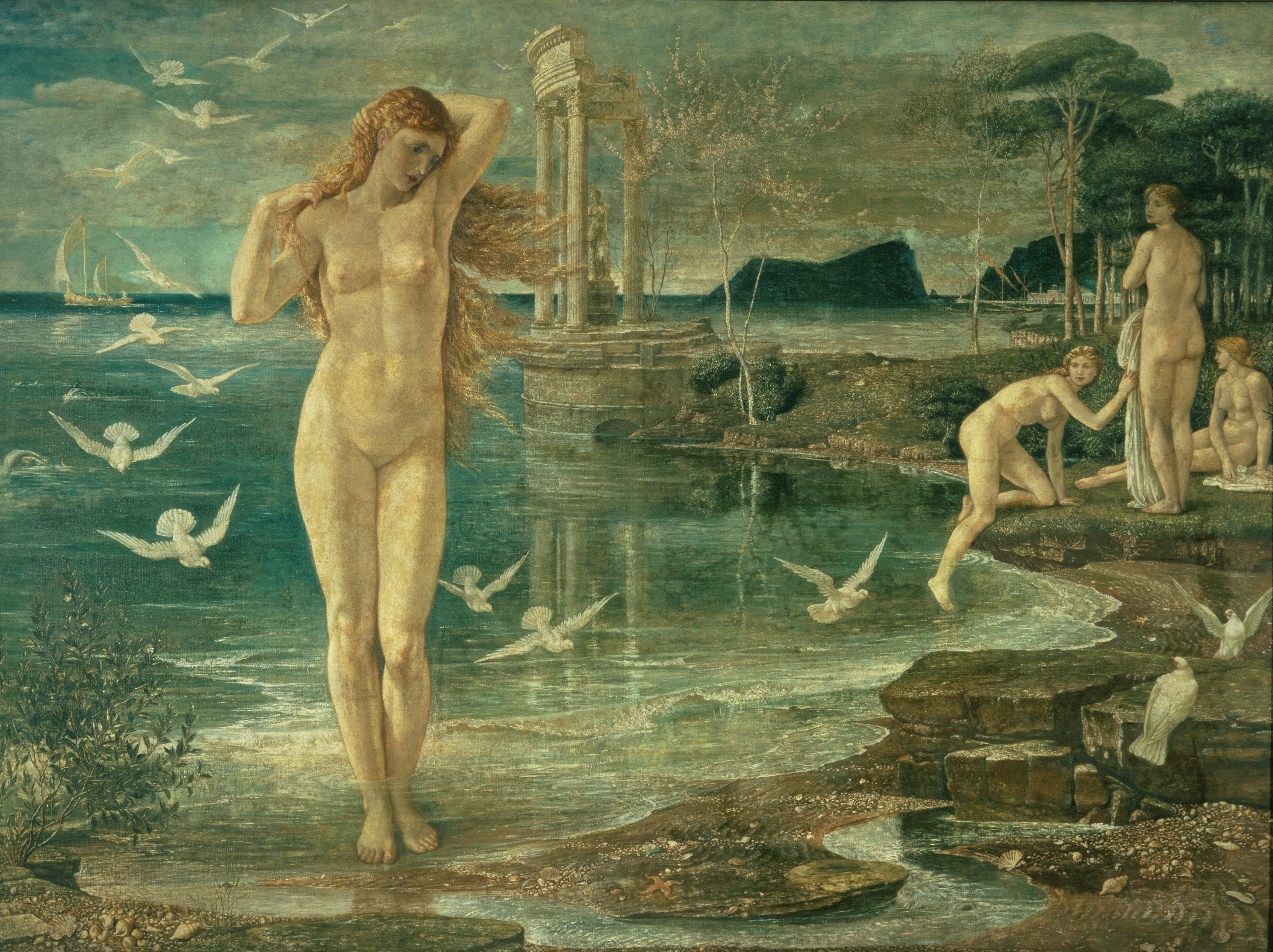
Walter Crane. The Renaissance of Venus. (1877).
The V&A's time-reversed sequencing brings us finally to In His Own Time, the section with real Botticellis. Two large 1490s variations of Venus against blank backgrounds from Botticelli's workshop, remind us that The Birth of Venus figure was a beauty icon in its own time. Pallas and the Centaur (1482) is another of his most powerful mythological works, yet oddly, artists have not re-imagined it. A calm young woman with a big axe could at a stretch resonate with empowered female heroines such as the Girl with the Dragon Tattoo, except she's apparently petting a centaur.
But mainly what we find here is a host of sacred paintings and portraits.
Botticelli painted the Virgin Mary, long Western art's icon of the perfect female, many times, and the V&A puts a strong selection of them up here. Three versions of Christ the Redeemer from his workshop are duly grim and pious. The Mystic Nativity (from about 1500) with its strange perspective has beauties, but hung in divinity's constricts (literally with its merry-go-round of floating angels). This is said to show the influence of the fire-breathing fundamentalist preacher Savonarola, who took control of Florence from the Medicis in 1494 and later instigated a sort of religious police. Botticelli fell under his spell. Botticelli's rough Mystic Cruxifiction suggests Savonarola's zealotry, if not his execution by fire in 1498. Clouds of doom seem about to overcome the scene.
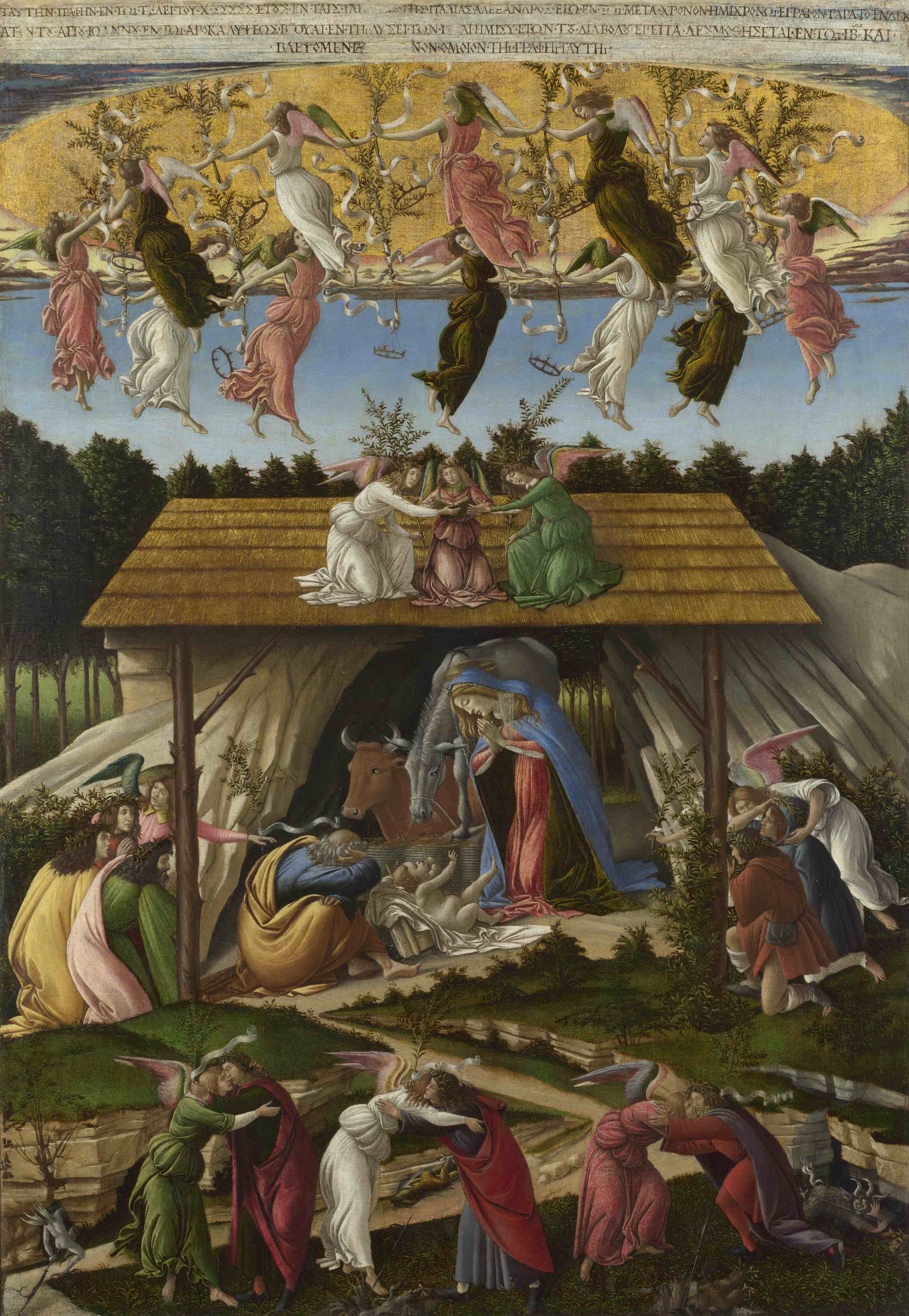
Sandro Botticelli. The Mystic Nativity. (1500-01). 108.5 cm × 74.9 cm (42.7 in × 29.5 in).
The sacred Botticelli, whether reverential or apocalyptic, is a no-show in modern art. We relate to his work from earlier, happier times than Savonarola's, when Florentine art was shaking free of the dour Medieval obsession with the sacred. Led by the enthusiasm of Botticelli's patron Lorenzo di Medici, Florence was revelling in rediscovered Roman and Greek myths and pagan roots, which gave Botticelli stages on which to express his humanist vision. As well as myths, the nobility also wanted portraits. Botticelli's were not like the severe and sometimes secular women which Flemish painters such as van Eyck or van der Weyden portrayed earlier in the fifteenth century, and who were known in Florence — his portraits were more ideal. And it in these we may find the Birth of his Venus.
A 16-year-old blonde arrived in Florence in 1469, married to become Simonetta Vespucci and cast a spell on the city. She was hailed as the most beautiful woman of the time. When Botticelli met her, he was blown away. The V&A present different Botticelli portraits of an ideal woman who is thought to be her, some if not all painted after her death from tuberculosis in 1476. Allegorical Portrait of a Lady, a ‘lactis' painting in which she squirts milk from a her breast but with no baby Jesus, is re-enacted by Cindy Sherman in Untitled #225, earlier in the show. Botticelli idolised and idealised Vespucci. There is no proof, but Botticelli's Venus, and other figures, are also likely to be her.
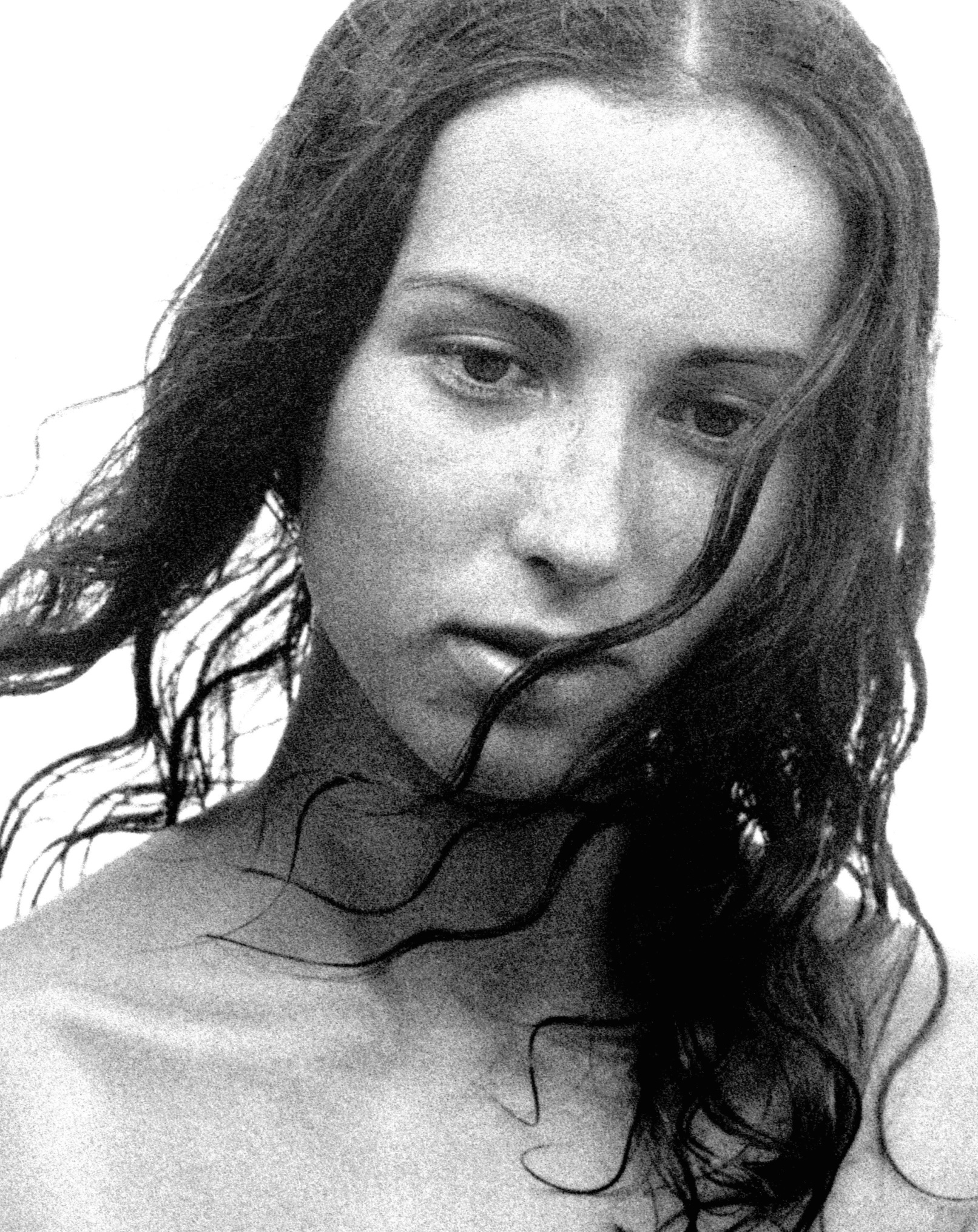
Paul Himmel. Botticelli Girl (Patricia McBride), Fire Island. 1955.
Just as fantastic, we meet Botticelli himself in the show, although just in a blow-up detail from a painting not there — The Adoration of the Magi (1475). In this presumed self-portrait, he stands aloof from those around the Virgin Mary, looking sideways at us, or perhaps through us to his reflection in a studio mirror, in awe of the power of his talents. Then again, maybe he is inviting us to witness the woman, here with baby Jesus, who had enchanted him.
Have we found out why Botticelli's Venus has been such a powerful image? Is it its endless amplification through popular media? Yes, but it's in a busy field. Is it just another case of gentlemen prefer blondes? There are plenty of blondes. In any case, Venus appeals to women as well. "I love the way she's just emerged, apparently effortlessly from the water, alluring and knowledgeable,” comments contemporary London artist Alex Blum. “But with a freshness and innocence which allows every viewer to project their own aspirations onto her. She’s like an empowering clean slate, full of hope for the future”.
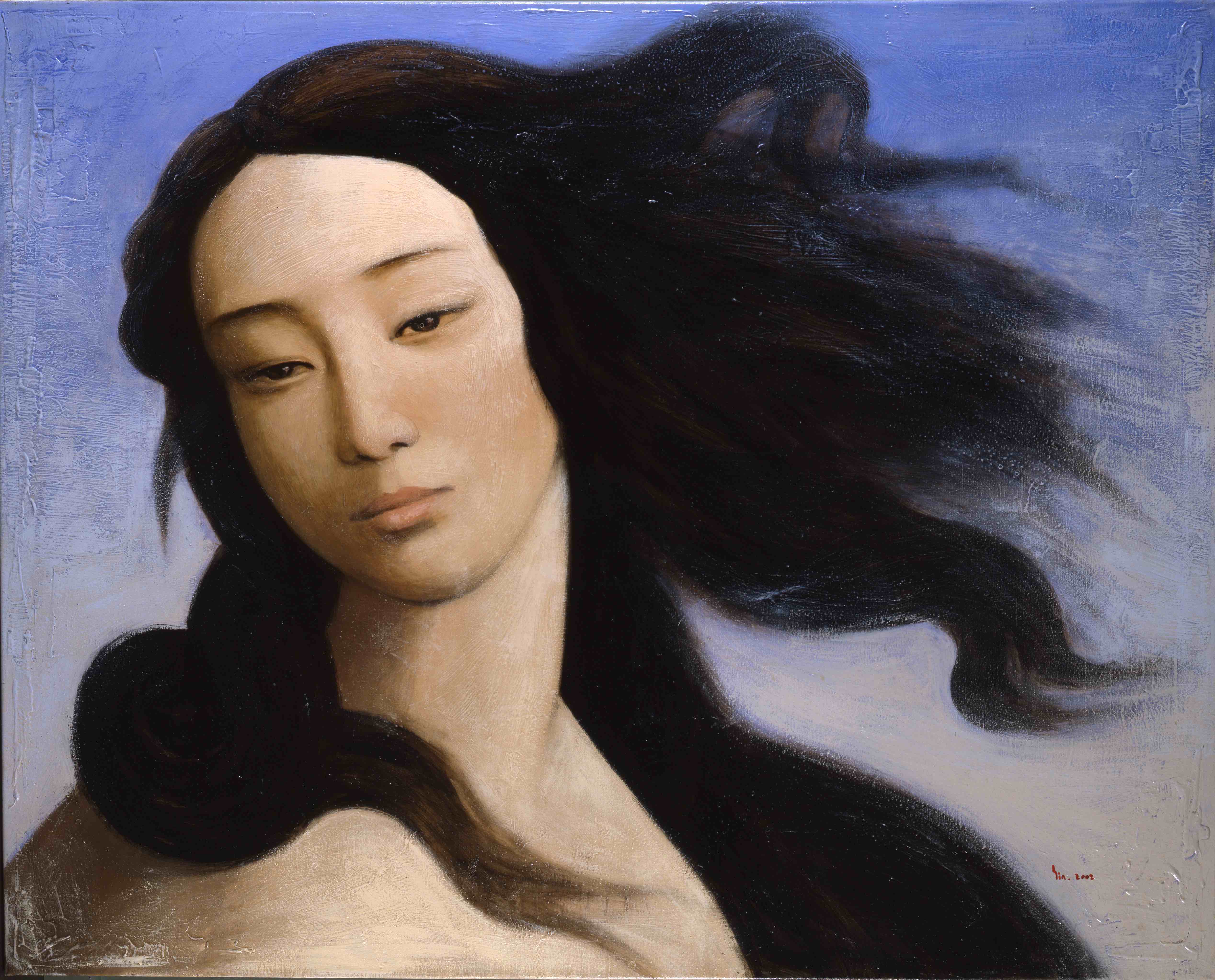
Yin Xin. Venus, after Botticelli. (2008).
Botticelli revealed a fantastic, secular vision: an idea of youth, freedom and oneness with nature. It is an idea that has resurfaced down the centuries. There are no images of ethereal hippies from 1967's Summer of Love in the V&A (although strangely Paul Himmel's 1955 photo portrait Botticelli Girl (Patricia McBride), Fire Island is a premonition of them), but their time resonates with the giddy, liberating air of Lorenzo di Medici's Florence.
By drawing on rediscovered ancient thought, the Renaissance would free rationalism to discover higher truths than those presented by the church. In Florence, it also challenged how we see ourselves — not as underlings in the divine scheme, but as free agents. Ultimately, that would allow us to create an image as liberated and liberating as Joel-Peter Witkin's God of Earth and Heaven, Los Angeles (1988), a photographic re-enactment of the Birth of Venus with transgender models, included in the show. Savonarola would not have liked it — just as today, joy-killing religious nuts hate free human expression.
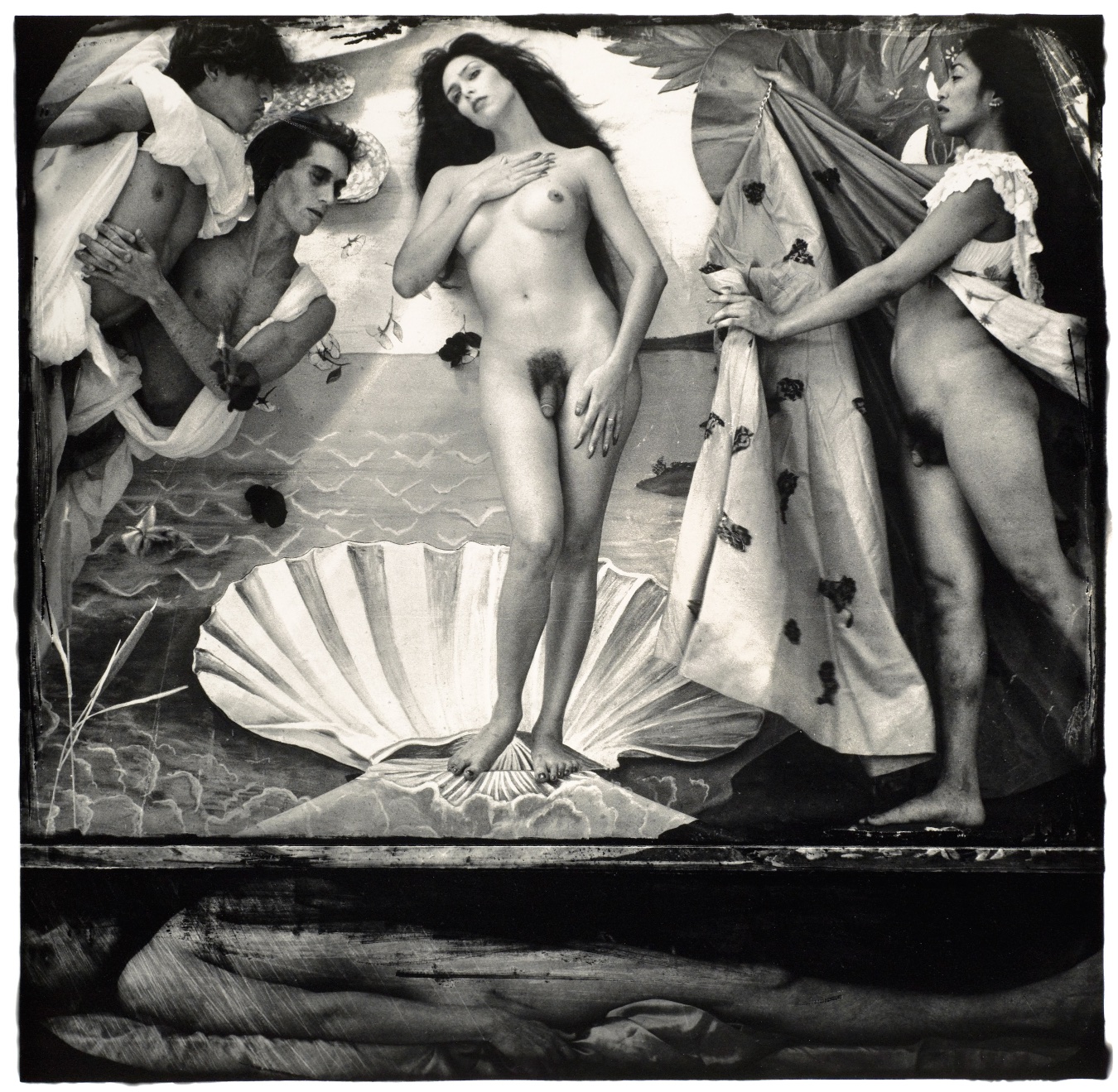
Joel-Peter Witkin. God of Earth and Heaven, Los Angeles. (1988).
It is strange, then, that Botticelli fell under the spell of Savonarola. But in the end, Vespucci's spell held longer and he was buried at her feet, as he had wished. He most likely crafted Venus' beauty from hers, and offered her like a humanist's alternative Eve, stepping out not from the Garden of Eden but from the great, elemental sea. She is pure, the perfect innocent, and so became an avatar for our devotion, anxieties or agendas. These create what Evans calls the 'adventure' Botticelli Reimagined presents.
Venus is the epitome of the cultural revolution that was the Florentine Renaissance. It's adventure has been even larger . . . it is civilisation's path into light.
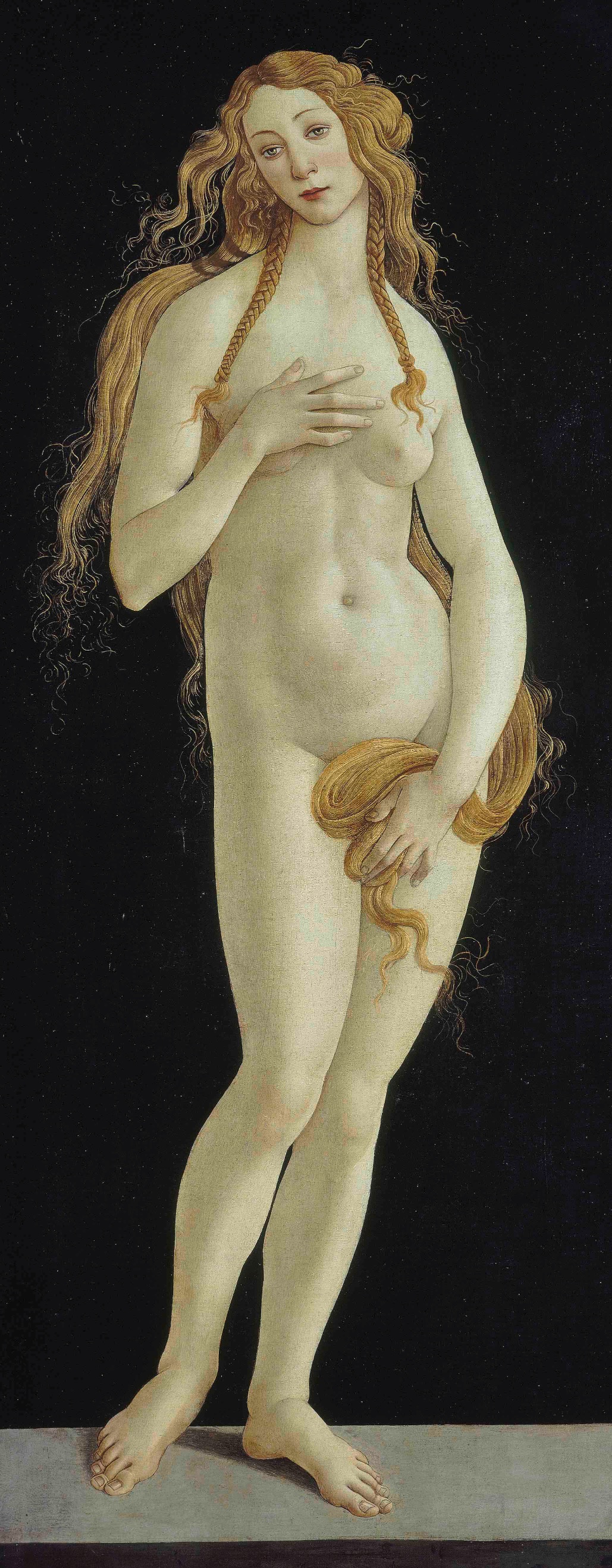
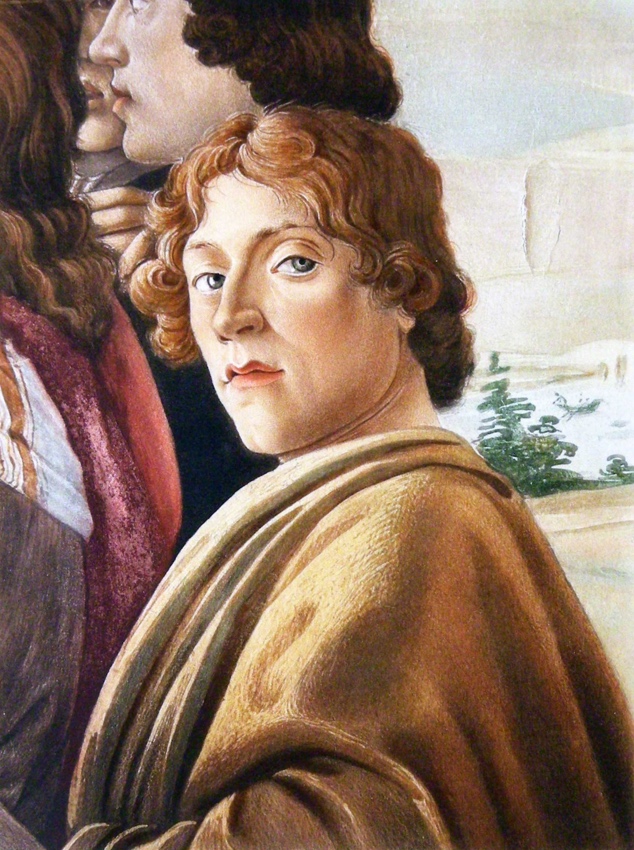
The artist, from a detail of Adoration of the Magi (1475).

HERBERT WRIGHT is a London-based author and journalist specializing in architecture and art, and Editor-at-Large of The Journal of Wild Culture. He studied physics and astrophysics at the University of London. He is currently a contributing editor of Blueprint magazine, and contributor-at-large to Design Curial. www.herbertwright.co.uk

Add new comment